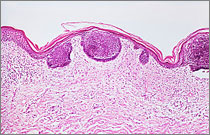Leukaemias
| 2020 | ||
|---|---|---|
¹ per 100,000 persons, age-standardised according to the old European standard population * calculated using the period method for 2019 / 2020 | ||
| Women | Men | |
| Incidence | 5,640 | 7,920 |
| Age-standardised incidence rate¹ | 8.0 | 12.9 |
| Deaths | 3,573 | 4,784 |
| Age-standardised mortality rate¹ | 3.5 | 6.4 |
| 5-year prevalence | 17,200 | 23,900 |
| 10-year prevalence | 30,000 | 40,300 |
| Relative 5-year survival rate* | 56 % | 60 % |
| Relative 10-year survival rate* | 50 % | 51 % |
Leukaemias are classified according to the speed of disease progression (acute, chronic) and the cell type from which they originate (myeloid, lymphatic).
The four most common forms of leukaemia are:
- Acute myeloid leukaemia (AML)
- Chronic myeloid leukaemia (CML)
- Acute lymphatic leukaemia (ALL)
- Chronic lymphocytic leukaemia (CLL)
In addition to these four main types, there are several other forms of leukaemia, but they are rare.
Frequency of leukaemias
In 2020, approximately 13,570 people in Germany were diagnosed with leukaemia, 4 percent of whom were under 15 years of age. The risk of developing leukaemia decreases in children and young adults with increasing age. At the age of 30 years, risk begins to increase again, with a higher incidence rate in men compared to women. One in 64 men and one in 90 women will develop leukaemia during their lifetimes.

![]() Age-specific incidence rates by sex, ICD-10 C91 – C95, Germany 2015 – 2016, per 100,000
Age-specific incidence rates by sex, ICD-10 C91 – C95, Germany 2015 – 2016, per 100,000
Between 1999 and 2020, age-standardised incidence rates remained relatively stable, while age-standardised mortality rates declined. At around 38 percent of newly diagnosed cases, chronic lymphocytic leukaemia (CLL) is the most common form.
| Proportion of leukaemias C91-C95 by type and sex, Germany 2019–2020 | |||||
| ALL | CLL | AML | CML | other | |
| Women | 6 % | 36 % | 27 % | 8 % | 23 % |
| Men | 5 % | 40 % | 22 % | 8 % | 25 % |
The prognosis for people with leukaemia depends on the form of the disease and the age of diagnosis: Children have by far the best survival prospects, while in adults the acute forms continue to have a rather poor prognosis. The relative 10-year survival rate is around 50% for women and men. In the case of chronic leukaemia, a cure can only rarely be achieved, e.g. by means of a high-risk stem cell transplant.
Ionising radiation increases the risk of leukaemia
No risk factor has been identified that affects all types of leukaemia. However, some factors increase the risk of developing certain leukaemias. Among the known risk factors for acute leukaemias are ionizing radiation and cytostatic drugs. Occupational exposure to benzene, 1,3-butadiene and related substances can also contribute to the development of leukaemia. Some rare genetic alterations can increase the risk of acute leukaemia, including trisomy of chromosome 21. Viruses have not been confirmed as a risk factor for leukaemia, with the exception of the human T-lymphotropic virus (HTLV), which is extremely rare in Europe. Several other risk factors are currently being discussed as causes of leukaemia. These include environmental influences as well as lifestyle factors such as smoking or excess body weight. However, a connection has not yet been proven.
For most patients with leukaemia, no clear cause can be found. It is likely that several factors must work together.
Date: 21.03.2024






